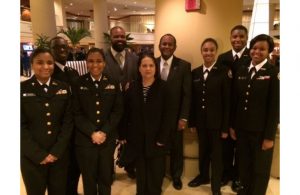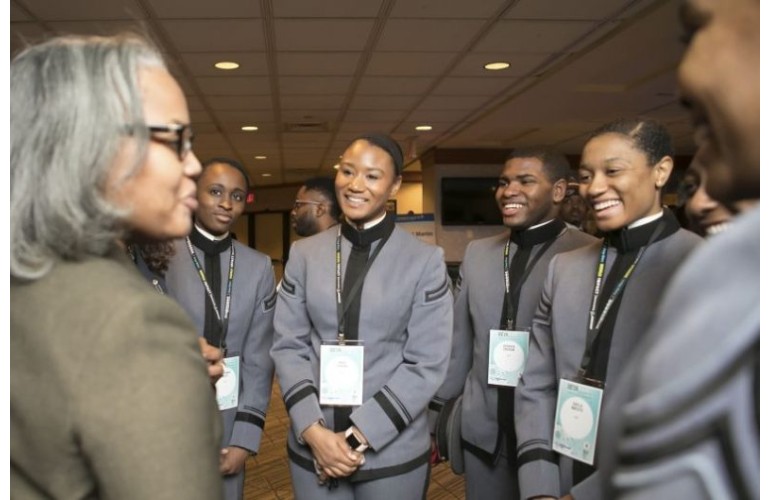 Subscribe
Subscribe- Login
-
/
Sign Up
- US Black Engineer
- >>
- Articles
- >>
- HBCU Technet
- >>
- BEYA’s Veterans and Military Families Month
|
Getting your Trinity Audio player ready...
|
 2018’s National Veterans and Military Families Month is almost over, so we close out with stories of BEYA STEM’s Stars & Stripes Military Community.
2018’s National Veterans and Military Families Month is almost over, so we close out with stories of BEYA STEM’s Stars & Stripes Military Community.
Stars & Stripes is comprised of many of the nation’s leading active duty and retired African-American military flag officers, and Department of Defense civilians in the federal Senior Executive Service.
Each February, they join thousands of people at the annual BEYA STEM Conference, which brings together students, professionals, and leaders in science, technology, engineering, and math (STEM) from industry, business, academia,
the government, and the military.
Some lucky STEM students get an education in the art of rubbing elbows through the Mentoring Program sponsored by the BEYA Stars & Stripes program.
Stars & Stripes members launched the program as part of a two-part pilot in 2014 to provide a six-year mentoring platform for students starting in high school through college and then into an entry-level STEM career.
At the BEYA conference held each February, Stars & Stripes members mentor students during an afternoon of the event and then invite them to attend the Stars & Stripes Dinner in the evening.
Vice Adm. (retired) Melvin G. Williams Jr., who served as co-chair of the Sustained Mentoring Program, said Stars & Stripes saw it as an opportunity to expand the group’s efforts in its mentoring activities during the BEYA Conference.
“We saw value in the one-day mentoring session, but we wanted to have something that was sustained,” Williams said.
A former associate provost for military and veterans affairs at George Washington University, he also administered Operation GW VALOR, a program that assists student military members and their families.
The goal of the BEYA Stars & Stripes program is to help stock the pipeline of black STEM professionals, Williams said.
While Stars & Stripes is comprised of members with ties to the military, Williams emphasized that the focus of the program is focused on nurturing STEM students rather than recruiting for the military.
“Because the STEM field is so challenging, we think that having the mentoring being persistent over that six-year period is critical,” he said.
Working closely with students is near and dear to Williams.
Personally, he is mentoring students at Suitland High School in Suitland, Md., in the Washington, D.C. area. Two of his mentees, who were members of the Navy Junior ROTC program at Suitland, are now pursuing STEM education at Morgan State University in Baltimore and Delaware State University.
“These young people are so excited. They really enjoy what we are doing. They are attentive and are asking questions. I’m learning from them as much as they are learning from me,” Williams said.
In working with the students, the program emphasizes character, competence, and commitment as a means for them achieving excellence, according to Williams.
In addition to Suitland, other schools partnering with the Sustained Mentoring Program include Phelps, Bell Multicultural and Ballou high schools in Washington, D.C.; T.C. Williams High School and Thomas Jefferson High School for Science and Technology in in Alexandria, Va.; and George Washington Carver High School in Philadelphia, where the BEYA conference was held in February 2016.
At Suitland, Comdr. Robert Clements, U.S. Navy retired, who operates the school Junior ROTC program, said his students are benefiting through the Sustained Mentoring Program in ways they probably can’t fully understand yet. That’s the networking result of such a program, he said.
“It’s getting you ahead of the game and getting an understanding of the system and being mentored and growing at a more accelerated rate. It is a phenomenal opportunity for a student to be able to take advantage of something like this,” Clements said, himself an ROTC student in college.
Clements said he typically brings 15-20 students to the BEYA Conference Stars & Stripes mentoring event to interact with active duty military officers. He recalls fondly one BEYA Stars & Stripes mentoring session, where Vice Adm. Bill Moran, the Navy’s chief of naval personnel said that he found a Suitland student bright and engaging.
“I just observe and wonder what could my life had been like if someone had been this way with me at the high school level,” Clements said. “To be in that presence and having those discussions at the table and hearing what’s being said, the influence and impact will resonate with the students.”
Mentoring occurs with monthly face-to-face session along with interactions online.
Williams also writes college letters of recommendations and invites them to attend BEYA Stars and Stripes Gala during the conference.
“We believe it can show the nation that through the efforts of the Stars and Stripes program we can essentially help to some extent to create a cadre of STEM professionals all the way into the career phase,” Williams said.


